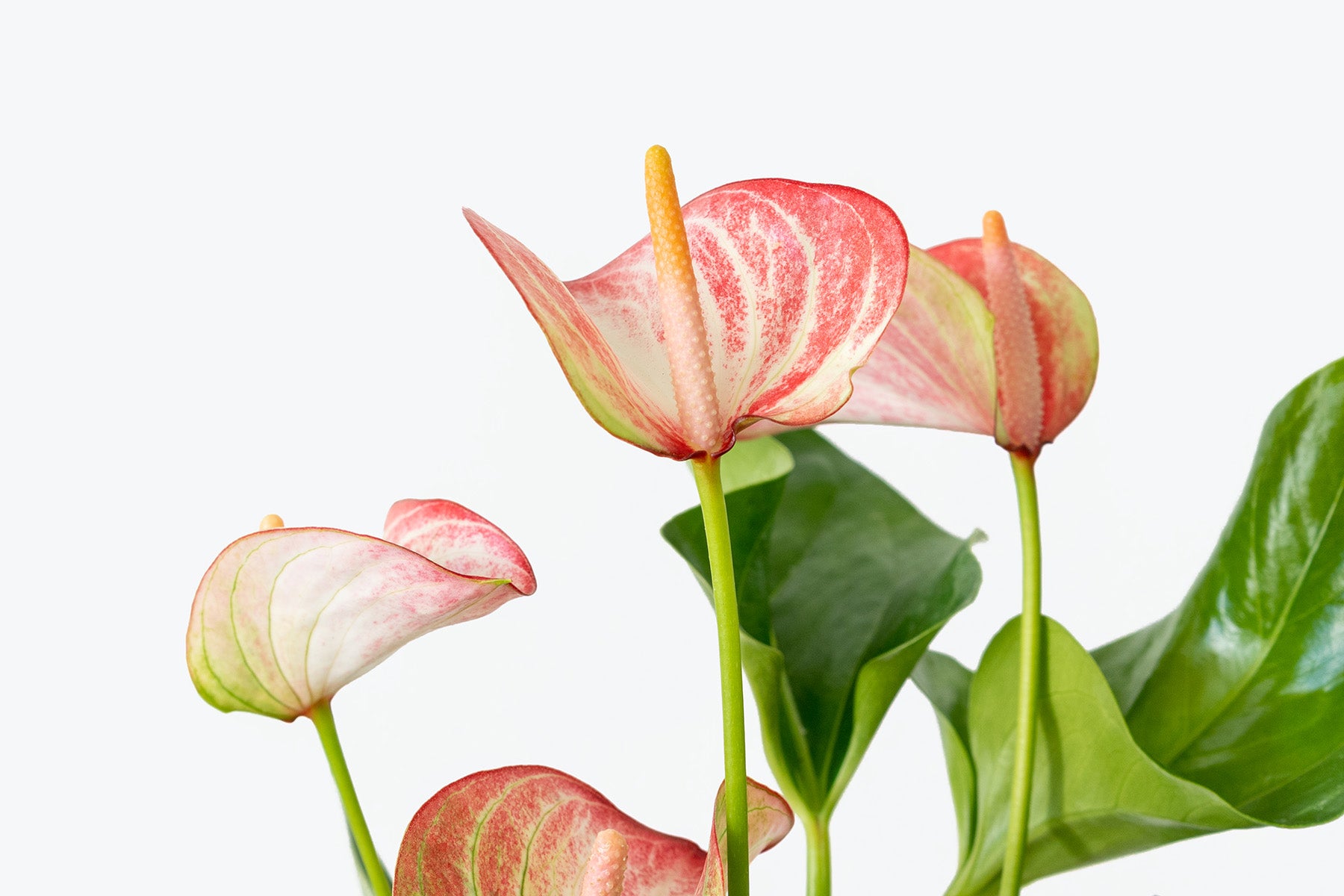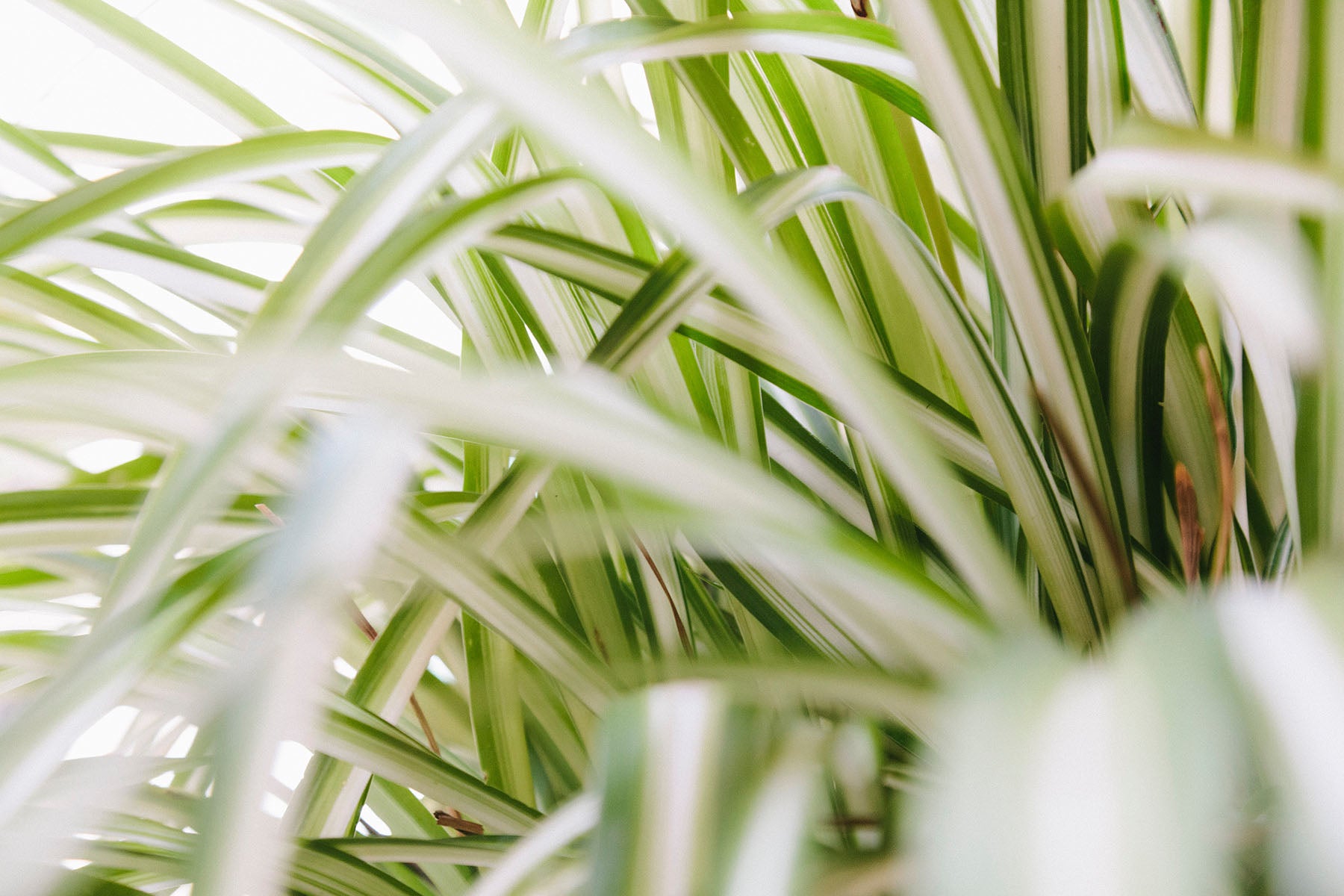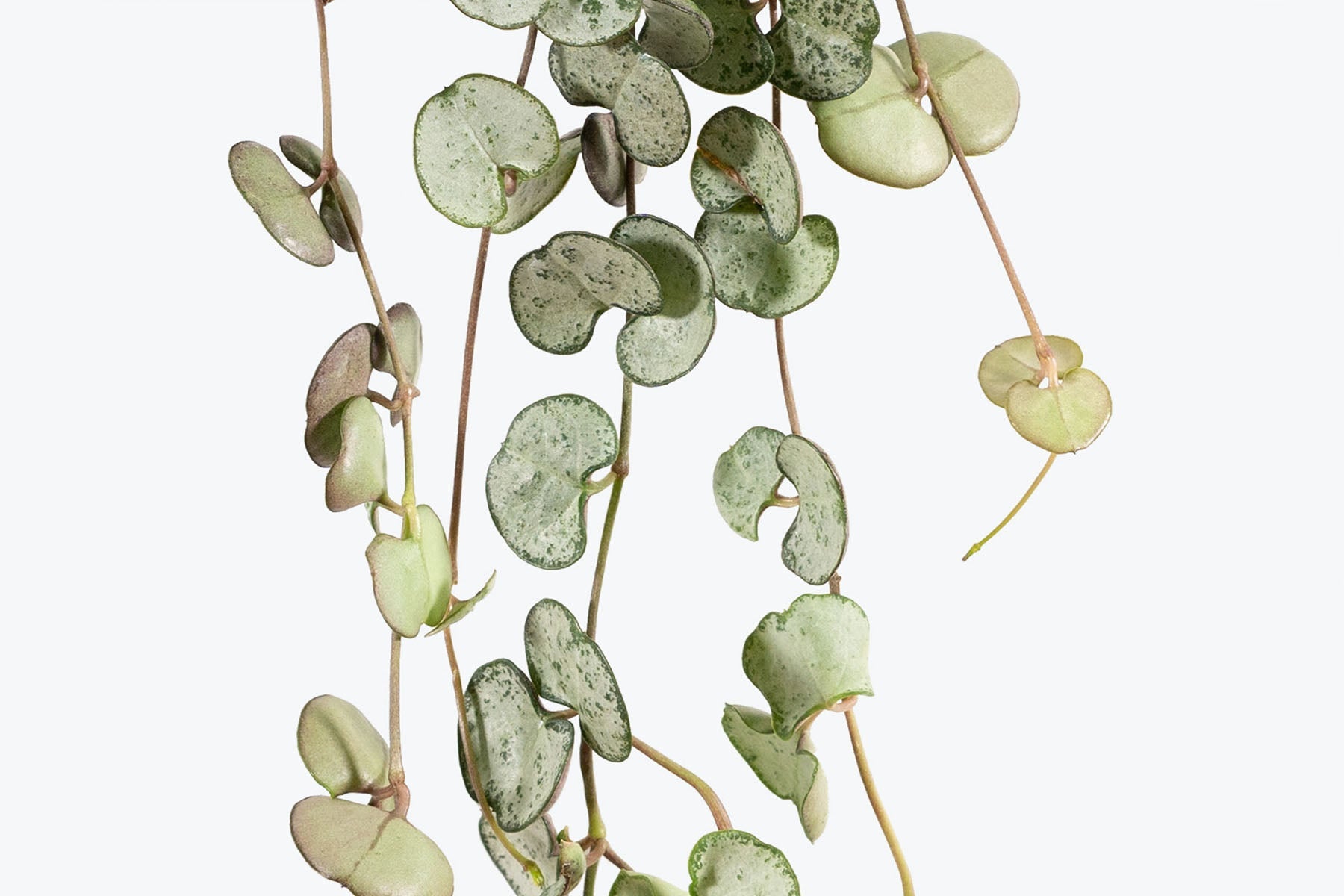
How to Take Care of Your Anthurium
One of the most popular flowering houseplants, besides the Peace Lily, is the Anthurium andraeanum, which is the world's longest blooming houseplant, with blooms lasting up to eight weeks! Also known as the Flamingo Flower, Tail Flower, Painted Tongue Plant, or Laceleaf, the classic, flowering Anthurium, which is a part of the Araceae family, is generally found in the warmest parts of South America and the Caribbean. There are plenty of varieties of Anthuriums, most of which are grown for their stunning foliage, but the most common Anthurium is one of the hardier varieties and much more forgiving than its counterparts.
△ 4" Anthurium Purple
Although Anthuriums are generally grown in a soil-based medium, in their natural habitat they are epiphytes, which are organisms that grow on the surface of another natural material (i.e. another plant), deriving their moisture and nutrients from the air, rain, water, or debris surrounding them. This is why they love a chunky soil mixture, such as one designed for aroids, preferring a well-draining, peat-based medium that provides plenty of air circulation. Since Anthuriums love moisture, but not overly soggy soil, a medium that is too dense can easily lead to root rot if the plant is given water too frequently. It would be much more effective to have a looser soil mix so that you are free to water more often without worrying (all depending on how much light your plant is receiving, of course).
🌈
The striking red, pink, yellow, and other coloured "flowers" are actually not the flower, but rather the spathe - a brightly coloured, waxy leaf! The true flowers are the tiny buds that form on the upright, fleshy spike in the middle of the spathe, which flares from the base of the spike.
As another feature of epiphytic plants, don't be alarmed if you start to see roots forming along the stems but above the soil, these are known as aerial roots. Their main function is to absorb water and nutrients directly from the air, so them growing means your plant is healthy and happy. Another sign of a happy plant is shiny new leaves and plenty of blooms. If this describes your plant in its current state, keep doing what you are doing because your plant is loving those favourable conditions!
Otherwise, if you are noticing some issues with your plant, like if it isn't flowering, or if you are unsure about any of the other care steps required to keep an Anthurium thriving, keep on reading because we cover everything they need in this care guide!
Light Requirements
First off: Lighting. As with most houseplants, placing your Anthurium in a location that receives bright, indirect light will encourage the fullest growth with plenty of flowers. In the case of the flowering Anthurium, they can also produce lots of lush foliage in medium light levels, they just may not produce many blooms (if any). This still means that they are healthy, they simply aren't receiving the light levels that they need to support their beautiful blooms, since that is one of the factors that affects bloom development.
☀️
The main thing that Anthuriums cannot handle is prolonged, direct, afternoon sunlight, as this could burn their leaves. Vice versa, if it is in a low light space, where the plant receives extremely indirect light, the growth would slow significantly and could become extremely stunted, leading to a struggling, stressed plant.
Light levels also change throughout the year, as there is a lot more light during the longer, warmer days of spring and summer, and a lot less light in the shorter, cooler days of the winter. You may have to move your plant in order to avoid too much light or not enough light, depending on the time of year. As long as your plant has a wide view of the sky from where it sits, it will be receiving some sort of natural light. Check out our Ultimate Lighting Guide for all the light levels possible in a home and their impact on plant growth.
Lighting Tip: Rotate your plant every week to get even growth on all sides!
The lowest light conditions that Anthuriums can handle, which would be in the medium light classification of the indoor lighting spectrum, include the following:
- In the middle of a room with a regular-sized South, West, or East facing window
- A couple of feet away from a North-facing window
- Next to a South, West, or East facing window that has obstructions (i.e. nearby condo, overhang, large tree, etc.)
△ 4" Anthurium Red
When in their lowest light settings, houseplants will more often retain the shape that they come in, or become “leggy”, where their leaves are more spaced out and growth is less compact. The rate of growth will also be slower, the size of the new leaves will probably be on the smaller side, and there may even be some leaf loss, as plants will shed what they can't support. In the case of Anthuriums, they will also rarely flower in low light. This is something to keep in mind when you are choosing where to put your plant!
🌸
Although Anthuriums flower quite easily, it greatly depends on the light they are receiving. With the right care and fertilization, as well as being kept slightly root-bound, flowers usually grow in cycles of 3 months - a few months of flowers and then a few months without flowers, each bloom lasting up to 6-8 weeks at a time. If you would like your plant to have a life of robust, repeated flowering, it is best to let your plant go dormant for about 6 weeks during the winter, where it is not fertilized, watered a little less, and kept in a slightly cooler location (it is still a tropical plant so avoid keeping it somewhere colder than 15°C).
In order to have your Anthurium producing plenty of new growth, and to encourage blooming, here are some ideal lighting recommendations for you to keep your plant in:
- Directly next to a North or East-facing window
- Next to, or close by, a South, Southwest, or West-facing window that has sheer curtains (only a couple millimetres thick) for some bright, diffused light. They cannot handle prolonged, direct sunlight so the curtains keep the leaves from getting burned, although morning or late afternoon sun will not be harmful.
- A meter or so away from a South, Southwest, or West-facing window without curtains or obstructions outside
- Bonus entry: a brightly lit bathroom would be a superior location, providing the light and humidity that Anthuriums love!
Of all plant care requirements, light levels have the greatest impact on plant growth and bloom production, so it is important to understand the light levels in your home and what you have available for your plants. If you want your plant to remain full and bushy, pushing out flowers and glossy growth, keep it in brighter light, if you are happy with a mainly foliage plant, keep it in medium light. Also, using clean, sharp scissors, trim any dead, discoloured, damaged, or diseased leaves and stems as they occur.
🌱
Try not to be concerned about every yellowing leaf on your plant. If there are no pests on your plant and it is pushing out healthy, new growth, your plant will shed its older leaves over time, sending the energy to this new growth. Yellowing leaves are all a part of the natural process.
Watering Requirements
Since they grow in the tropics in their native environment, Anthuriums enjoy humid, moist conditions, but not overly soggy soil. Water your plant when the top half of the soil is dry to the touch, which can be checked by sticking your fingers into the soil to feel for the moisture levels. If you are ever confused, your plant will communicate to you when it is thirsty when the leaves begin to droop, or pucker, and the pot feels light. Water the potting mix thoroughly, until it is evenly moist, allowing any excess water to drain out and dump this excess.
🚨
Avoid letting your plant get extremely wilted, this can cause brown tips on your plant, as well as resulting in some leaf loss. Also, letting your plant go from extremely dry to extremely soaked very often can stress a plant out, which can lead to browning on leaves and leaf loss as well. Although they will tolerate missed waterings, you never want to let it go too far. Keep the soil of your plant evenly moist, not soggy but not bone dry.
As for the frequency of watering, or how often to water, that will all depend on the light your plant is receiving, the warmth and humidity of your home, the size of the pot, as well as the pot that the plant is planted in. Generally, no two plants will be on the exact same watering frequency, as everyone's home is different! You should expect to water your plant more often in the spring/summer months though, when the days are longer, warmer, and brighter, and less often in the winter months when the days are shorter, cooler, and darker. In other words, you should expect to water a plant that is in brighter light more often than the plant that is in lower light.
📋
When it comes to giving Anthuriums larger homes, it is best to check the roots every couple of years to see if it is time to repot. The need to repot will show its face in the form of crowded roots, stunted growth, extremely compacted soil (depriving the roots of oxygen), or a build-up of leached salts from fertilizer over time. These soil conditions can cause your Anthurium stress and prevent it from growing healthy new growth or blooms. To learn more about when and how to repot, please see our Repotting Guide.
Due to their epiphytic nature, Anthurium roots love moisture, but they are also used to being exposed to a healthy airflow, not living in dense, wet soil. Therefore, a chunky, well-draining soil, which will keep the soil from staying too moist for too long, is the best medium to keep your plant in. As long as there is some sort of aggregate in the soil, such as perlite, vermiculite, charcoal, lava rocks, orchid bark, or coconut coir, the soil will not become too compact and will allow for some airflow throughout the soil.
Humidity
Anthuriums love humidity! Although they can handle lower humidity levels, the wear and tear of dry air will begin to show on their leaves, through crispy tips or yellow edges. Lack of humidity will also cause the foliage to lose its beautiful sheen, which is an adaptation to their natural, moist, rainforest environment. The loss of this gloss will reduce your plant's resilience over time and could also affect its ability to flower.
△ 6" Anthurium Pink
Anthuriums would much rather live in a warm (at least 20 C), humid (around 50%) environment. If you are willing to spend the extra time and effort, here are some ways you can increase the humidity in the air around your plant:
- Mist your plant's leaves every day (or multiple times a day) to increase the ambient humidity for a short period of time around the plant
- Grouping your plants together will create a humid microclimate since they release moisture through their leaves in a process called transpiration. It would be best to collect plants that have similar humidity needs together.
- Place the nursery pot on top of a bed of rocks, or pebbles, that are just covered in water (this increases the humidity in the air around the plant)
- Invest in a humidifier to increase the overall humidity in the room (this will benefit any other plants you have as well)
Be sure to keep them away from any drafts, such as cold windows or doors in the winter, cold rooms, radiators, or any heating/air conditioning vents blowing air. Try to make sure there is some sort of general air circulation in the room that they are in, not directly blowing air on the foliage. Avoiding temperature extremes or sudden temperature changes would also be beneficial since plants that are too cold tend to not grow, as if they are forced into dormancy, and plants that are too hot will become wilted.
They are still tropical plants so they won't do well being placed in a cool, dry area in the long run!
Fertilizing
There are plenty of different instructions for fertilizing Anthuriums, some that recommend it more often with an extremely diluted option, and others that recommend it less often with a less-diluted option. We advise feeding your plant during the growing seasons of spring and summer about once a month with a diluted fertilizer, down to a quarter strength. Using a organic liquid fertilizer that is high in phosphorous would be very useful to encourage blooms in your plant as well! Too much fertilizer can do more harm than good, so practice less is more if you are unsure.
Toxicity
Since they are toxic to both humans and pets due to the calcium oxalate crystals that all parts of the plant contain, Anthuriums are best kept away from children and animals. If ingested, and depending on how much, they can cause stomach and respiratory irritation, which can lead to possible vomiting. The juices from the plant can also irritate your skin, so make sure to use gloves when working with them or wash your hands right after handling them.
Common Pests & Problems
Anthuriums generally don't have too many problems when it comes to pests and other issues. That being said, even though most of these problems don't occur all the time, we still want to outline any possible issues you could experience while having them in your care:
Over-watering:
When the stems and leaves are yellowing or mushy, you are most likely experiencing a watering issue, where the soggy soil has caused the roots to rot. If the problem isn't too bad, hold off on watering as we state above. If there is too much damage, remove some soil from the root ball, gently trim any rotted roots off with clean shears, and repot your plant into fresh, chunky soil, following our watering guidelines.
Brown or yellow leaves:
These can be a result of too much or too little water, humidity issues, fertilizer issues, or lighting issues. Compare your plants current environment to our recommended environment above and adjust as needed!
No flowers:
When an Anthurium doesn't receive enough light, is in soggy soil, or has improper humidity, it may not produce flowers. Move your plant to a location that receives brighter light and make sure to keep it slightly root-bound. If your plant is already in a bright location, increase how often you fertilize to encourage flowers (try using a fertilizer with higher amounts of phosphorous).
Green flowers:
These are often an indicator of a new sprout that was forced to bloom when the plant should have been resting, that's why the 6-week rest period during the plant's winter dormancy is important.
Anthuriums are definitely a great addition to your home because they are incredibly strong, stunning plants and are quite simple to take care of. They also make amazing gifts for friends and family during the holidays, housewarmings, or thoughtful gestures, with their beautiful blooms and glossy foliage, just send this care guide along with them!









